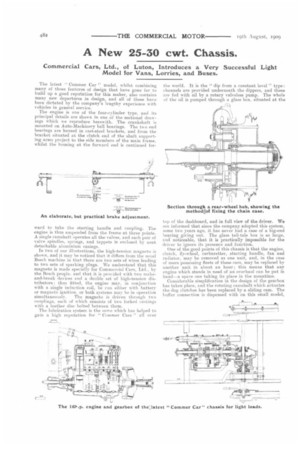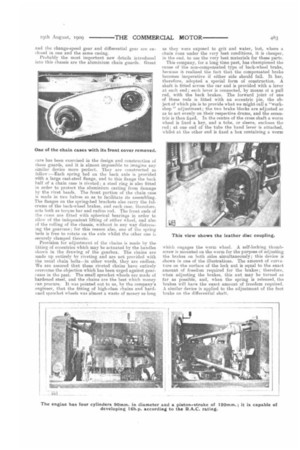A New 25-30 cwt. Chassis.
Page 2

Page 3

If you've noticed an error in this article please click here to report it so we can fix it.
Commercial Cars, Ltd., of Luton, Introduces a Very Successful Model for Vans, Lorries, and Buses. Light
The latest " Commer Car " model, whilst combining many of those features of design that have gone far to build up a good reputation for this maker, also contains many new departures in design, and all of these have been dictated by the company's lengthy experience with vehicles in general service.
The engine is one of the four-cylinder type, and its principal details are shown in one of the sectional drawings which we reproduce herewith. The crankshaft is mounted on Auto-Machinery ball bearings. The two end bearings are housed in cast-steel brackets, and from the bracket situated at the clutch end of the shaft supporting arms project to the side members of the main frame, whilst the housing at the forward end is continued for ward to take the starting handle and coupling. The engine is thus suspended from the frame at three points. A single camshaft operates all the valves, and each pair of valve spindles, springs, and tappets is enclosed by neat detachable aluminium casings. In two of our illustrations, the high-tension magneto is shown, and it may be noticed that it differs from the usual Bosch machine in that there are two sets of wires leading to two sets of sparking plugs. We understand that this magneto is made specially for Commercial Cars, Ltd., by the Bosch people ind that it is provided with two makeand-break devices and a double set of high-tension distributors; thus fitted, the engine may, in conjunction with a single induction coil, be run either with battery or magneto ignition, or both systems may be in operation simultaneously. The magneto is driven through two couplings, each of which oonsists of two forked castings with a leather disc bolted between them.
The lubrication system is the same which has helped to gain a high reputation for " Commer Cars " all over
the world. It is the " dip from a constant level " type: channels are provided underneath the dippers, and these are fed with oil by a rotary valveless pump. The whole of the oil is pumped through a glass box, situated at the
top of the dashboard, and in full view of the driver. We are informed that since the company adopted this system, some two years ago, it has never had a case of a big-end bearing giving out. The glass tell-tale box is so large, and noticeable, that it is practically impossible for the driver to ignore its presence and function.
One of the good points of this chassis is that the engine, clutch, fly-wheel, carburetter, starting handle, fan and radiator, may be removed as one unit, and, in the case of users possessing fleets of these ears, may be replaced by another unit in about an hour ; this means that any engine which stands in need of an overhaul can be put in hand—a spare one taking its place in the meantime.
Considerable simplification in the design of the gearbox has taken place, and the rotating camshaft which actuates the clog clutches has been replaced by a sliding cam. The buffer connection is dispensed with on this small model,
and the change-speed gear and differential gear are enclosed in one and the same casing. Probably the most important new details introduced into this chassis are the aluminium chain guards. Great
care has been exercised in the design and construction of these guards, and it is almost impossible to imagine any similar device more perfect. They are constructed as follow :—Each spring bed on the back axle is provided with a large cast-steel flange, and to this flange the back half of a chain case is riveted; a steel ring is also fitted in order to protect the aluminium casting from damage by the rivet beads. The front portion of the chain case is made in two halves so as to facilitate its assembling, The flanges on the spring-bed brackets also carry the fulcrums of the back-wheel brakes, and each case, therefore, acts both as torque bar and radius rod. The. front ends of the eases are fitted with spherical bearings in order to allow of the independent lifting of either wheel, and also of the rolling of the chassis, without in any way distressing the gearease; for this reason also, one of the spring beds is free to rotate on the axle whilst the other one L securely clamped thereto.
Provision for adjustment of the chains is made by the fitting of eccentrics which may be actuated by the handles shown in the drawing of the gearbox. The chains are made up entirely by riveting and are not provided with the usual chain bolts---in other words, they are endless. We are assured that these riveted chains have entirely overcome the objection which has been urged against geareases in the past. The small sprocket wheels are made of hardened steel, and the chains are the best which money can procure. It was pointed out to us, by the company's engineer, that the fitting of high-class chains and hardened sprocket wheels was almost a waste of money so long
as they were exposed to grit and water, but, where a chain runs under the very best conditions, it is cheaper, in the end. to use the very best materials for these parts.
This company, for a long time past, has championed the cause of the non-compensated type of back-wheel brake, because it realized the fact that the compensated brake becomes inoperative if either side should fail. It has, therefore, adopted a special form of construction. A shaft is fitted across the car and is provided with a lever at each end ; each lever is connected, by means of a pull rod, with the back brakes. The forward joint of one of these rods is fitted with an eccentric pin, the object of which pin is to provide what we might call a "workshop " adjustment ; the two brake blocks are adjusted so as to act evenly on their respective drums, and the eccentric is then fixed. In the centre of the cross shaft a worm wheel is fixed a key, and a tube, or sleeve, encloses the rod ; at one end of the tube the hand lever is attached, whilst at the other end is fixed a box containing a worm which engages the worm wheel. A self-locking thumbscrew is mounted on the worm for the purpose of adjusting the brakes on both sides simultaneously ; this device is shown in one of the illustrations. The amount of curvature on the surface of the lock nut is equal to the exact amount of freedom required for the brakes; therefore, when adjusting the brakes, this nut may be turned as far as possible, and, when the spring is released, the brakes will have the exact amount of freedom required. A similar device is applied to the adjustment of the foot brake on the differential shaft.






















